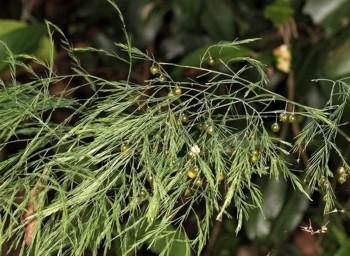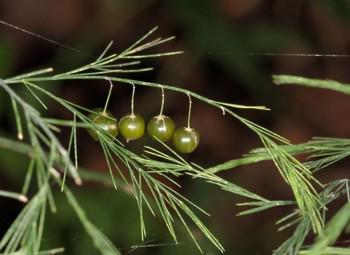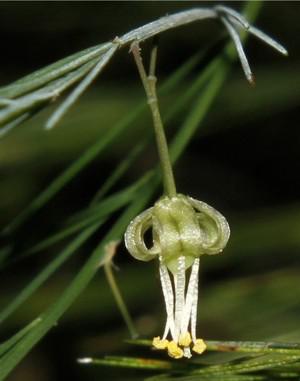Asparagus virgatus
Asparagus virgatus Baker
Family: Asparagaceae
Common names: broom asparagus, slender asparagus, ‘Tiki’ fern, African broom fern (Eng.); makkatdoring, katstertjie (Afr.); ibutha, ihabiya, iphinganhloya, unwele (isiZulu)
Introduction
Asparagus virgatus is an evergreen, perennial plant that produces small, greenish white flowers in summer, and small, spheroid, red seeds. It is also known as ‘Tiki’ fern and African broom fern, but, it is not a fern.

Description
Description
Asparagus virgatus is an erect, stiff shrub, 0.2–1 m high. It consists of branching stems with tiny, soft, thread-like leaves arranged like a wispy broom at the stem tips and curved upwards. The thread-like leaves mature after the flowers.
The greenish white flowers with recurved tepals, are found hanging along the branches in summer, and are inconspicous. It produces attractive red fruits (± 5 mm in diameter) that are found dangling on slender penduncles.

Conservation Status
Status
According to the Red list of South African plants, Asparagus virgatus was not screened as potential taxa of conservation concern, and was given an automatic status of LC (Least Concern).
Distribution and habitat
Distribution description
In South Africa, Asparagus virgatus occurs in all the provinces except the Western and Northern Cape, and is most common in KwaZulu-Natal. Its distribution extends northwards into Swaziland and Mozambique. The species grows in low-lying scrub and forest at altitudes from about 10 to 1 680 m above sea level.
Derivation of name and historical aspects
History
Asparagus is the largest genus in Asparagaceae and consists of approximately 200 species, which are distributed throughout the old world. All Asparagus species are characterized by the presence of photosynthetic stems called cladodes, even though they are represented by diverse life forms, such as herbaceous perennials, tender woody shrubs and vines. The name Asparagus is derived from the Greek words, Asparagos, for the cultivated asparagus, and is possibly derived from a, meaning ‘intensive’, and sparassa, ‘to tear’, referring to the sharp spines of many species. The name virgatus comes from the Latin word virga meaning ‘twig’ or ‘stalk’, in reference to the way the leaves cluster at the top of the stems.

Ecology
Ecology
Asparagus virgatus is generally browsed by animals. Its seed is dispersed by birds.
Uses
Use
Asparagus virgatus is used as a protective charm and also as traditional medicine to treat syphilis and intestinal worms. Unlike Asparagus officinalis, the species is reported to have no nutritional value for humans. It is very attractive, mostly used as cut flowers and also to decorate the gardens. Its cut foliage lasts long in floral arrangements. This species, appreciated because of the feathery or fernlike appearance of its branches, is used as landscape plantings in warm climates, and also by florists in bouquets and floral arrangements. It can be cultivated as an ornamental and is an excellent ground cover for shady spots in the garden.

Growing Asparagus virgatus
Grow
Broom asparagus produces many fruits with fertile seeds that readily germinate. It also produces underground stems which enable it to spread quickly. Grow it using seeds in full or partial sun and fertile, well-drained garden soil. Asparagus virgatus is considerably drought tolerant once established, but, looks best watered regularly. The species is very attractive when it is planted in containers, hanging baskets or cutting gardens.
References
- Pooley, E. 1998. A field guide to wild flowers Kwazulu-Natal and the eastern region. Natal Flora Publications Trust, Durban.
- http://www.learn2grow.com/plants/asparagus-virgatus/
- http://Redlist.sanbi.org
- Sahrawat A.K., Kumar, P. & Sahrawat, A. 2014, Asparagus racemosus—wonder plant. International Journal of Advanced Research, Vol. 2, Issue 4, 1039–1045.
- Stamps, R.H. & Rock, D.K. 1999. Effects of four elements on color, yield and vase life of Tree ‘Fern’ Asparagus virgatus. Proceedings of the Fla, State Hort. Soc. 112: 282–285.
Credits
Aluwani Tshiila
KwaZulu-Natal Herbarium
February 2015
Plant Attributes:
Plant Type: Shrub
SA Distribution: Eastern Cape, Free State, Gauteng, KwaZulu-Natal, Limpopo, Mpumalanga, North West, Northern Cape
Soil type: Sandy, Loam
Flowering season: Spring
PH: Acid, Neutral
Flower colour: White
Aspect: Shade, Morning Sun (Semi Shade), Afternoon Sun (Semi Shade)
Gardening skill: Easy
Special Features:
Horticultural zones











Rate this article
Article well written and informative
Rate this plant
Is this an interesting plant?
Login to add your Comment
Back to topNot registered yet? Click here to register.